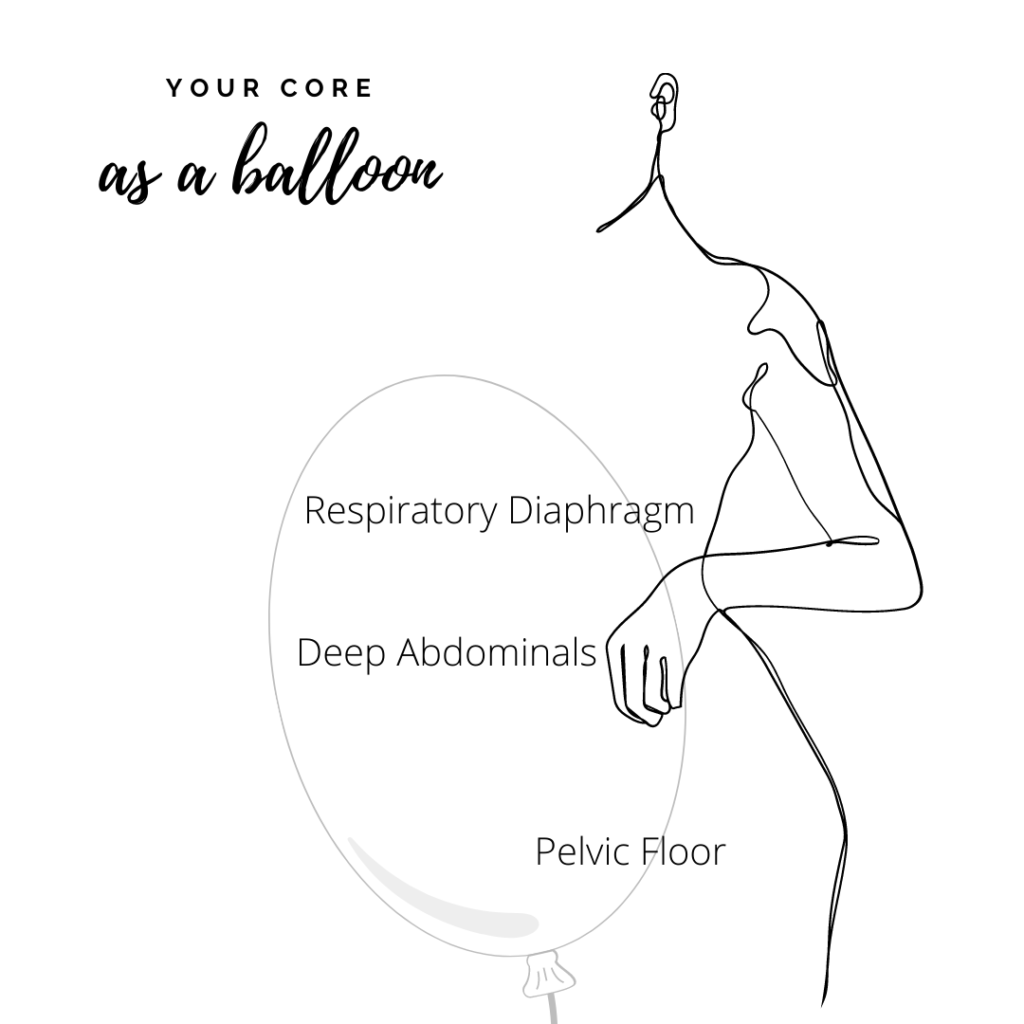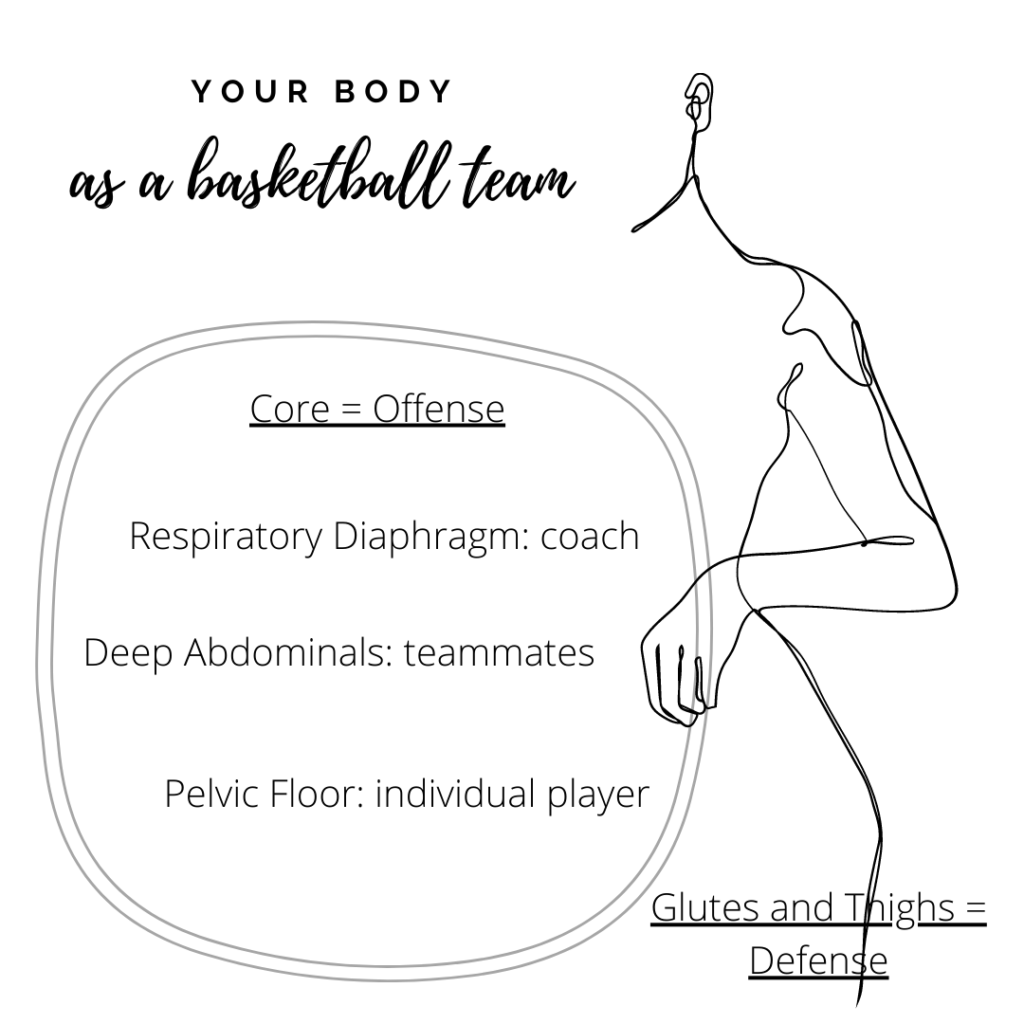Hi there! I’m Christina, a mom of two littles, a licensed mental health therapist, and a soon-to-be children’s book author! Thanks for checking out my site. Look around! I’m sure there’s something here for you! This guest article by Dr. Angela Turnow provides a basic overview of postpartum care for your core and pelvic floor. She explains how the two are related, and what that means in postpartum recovery for bladder leaks, prolapse, and abdominal separation, also know as diastasis recti abdominis.
Strong Core vs. Strong Pelvic Floor — They’re not mutually exclusive
The postpartum period is more than pads, ice packs and tucks wipes. This is the rebuilding phase for mom. Postpartum recovery is not losing weight or “getting your body back”. Instead, it is re-building a strong base to feel supported with your body.
Did you know rebuilding a strong core and pelvic floor are not separate goals?
The core and pelvic floor muscles play off each other.
This means, if one fails, so does the other. It can be eye opening to most moms that abdominal exercises alone will not create a strong core, and kegels alone will not produce a strong pelvic floor.
Our core contains our pelvic floor
The core consists of many muscles, including those for breathing, pelvic floor, and our deep abdominals.
We can think of our core like a balloon; the top is the respiratory diaphragm, bottom are the pelvic floor muscles and sides are the deep abdominals.

Each part impacts the others; similar to a balloon. If one part of a balloon had a hole, that would impact the entire balloon.
The core is the same way.
If one part of the core isn’t working correctly, the core becomes dysfunctional, which can lead to issues such as bladder leaks, prolapse, hip or back pain, painful sex, worsening abdominal separation and more.
In this way, traditional abdominal exercises such as planks, crunches, or V-sits will not lead to a strong core. Similarly, kegels will not stop bladder leaks.
Instead, it matters how the system works together.
One part is not more important than another. However, this is typically overlooked.
How the core and pelvic floor work together
People can get caught up in searching for the best ab exercises without addressing how the players (breathing, pelvic floor and deep abdominals) work together.
For example, pelvic floor muscle tension could be the reason for abdominal separation that isn’t improving. This means you could be doing all the best ab exercises, without seeing results. This is because pelvic floor muscle tension creates outward pressure on your weakened abdominal midline.
It’s kind of like how when you squeeze the bottom of a balloon it would increase pressure outward on the sides of the balloon (deep abdominal midline).
For the same reason, drawing your navel to spine with ab exercises, holding in your abs or sucking in your belly button can contribute to pelvic floor issues. It’s kind of like if you were to squeeze the middle of a balloon. This would place increased pressure down on the bottom of the balloon (pelvic floor). These pelvic floor issues could be bladder leaks or prolapse. Prolapse is when the pelvic organs (bladder, uterus, or rectum) fall into the vaginal opening to various degrees.
Sucking in your belly button can also disburse pressure upwards on the respiratory diaphragm, which creates dysfunctional breathing. This can lead to mid back pain, neck and shoulder pain, and perpetuate feelings of anxiety due to the effects of shallow breathing.
A strong core is more than abs. A strong pelvic floor is more than kegels.
Your body as a basketball team
Additionally, you can think of the body as a basketball team.
In this example the core is the offense. In your offense you have the coach (respiratory diaphragm), an individual player (the pelvic floor), and the teammates (deep abdominals). The defense would be the supporting muscles such as the glutes and inner thighs.

Similar to a basketball team, the coach — breathing in your diaphragm — calls the play. How you breathe matters.
Guess what happens when you are pregnant with a baby pushing up against your respiratory diaphragm. Your breathing most likely changes. The respiratory diaphragm must coordinate with the pelvic floor muscles. This is where meditation, body scanning, and body awareness are beneficial for pregnancy, childbirth and postpartum recovery.
The ability to learn correct diaphragmatic breathing is essential for a strong core and pelvic floor.
Similar to a basketball team, each individual player — the pelvic floor — must be able to dribble, pass, and shoot. As such, the pelvic floor muscles must be able to lengthen and contract. This is where kegels can be a problem if you are only focusing on contracting. The pelvic floor’s ability to contract and relax, or lengthen, is important for core function.
As a side note, most people need to actually learn to lengthen and relax their pelvic floor muscles because they carry pelvic floor muscle tension.
The success of the core, same as a basketball team, depends on how the entire team plays together. This means, all parts of the core must work together. One part is not more important than another.
Another factor to consider is how well the surrounding structures support the core. It’s kind of like how the defense in basketball helps to support the offense. In particular, looking at how well the side booty (glutes), inner thighs (adductors), mid back mobility (thoracic spine), and body mechanics help to support the core and pelvic floor for recovery.
Test your core function
To test your core function, you can try this simple test:
Place a hand on your lower belly and cough.
Did your belly go outward? Did you feel pressure in your vagina? If you answered yes, this is not what we want.
When you cough, sneeze, or laugh, what I want you to feel is an upward scooping of the lower abdominals. You should feel a squeeze and lifting action of your pelvic floor (vagina) muscles. This is done without moving your spine or tucking your butt.
A strong core in pregnancy and postpartum means addressing breathing, pelvic floor and deep abdominals muscle coordination. Similar to a balloon, each part impacts the other parts. Similar to a basketball team, the success of the core depends on how the team plays as a whole; and how well the defense supports the offense.
What does your core need?
If you want to stop bladder leaks, you might need a stronger side booty and inner thighs, or you might need to learn how to move more healthily. Maybe you need to improve mid-back mobility for better breathing. You may need to work on muscle tension with things like meditation to manage anxiety and stress.
If you want a stronger core and pelvic floor, we need you to stop searching for best exercises and to start addressing how the system is working together. You are only as strong as your weakest link. The core and pelvic floor work together. This means, if one fails so does the other.
Start to rebuild a strong foundation with breathing, pelvic floor and deep abdominal muscle connection with good movement strategies. You can find out more about these strategies on my website.
Having a strong foundation that involves the whole system is the key to improve pelvic floor and core issues (bladder leaks, prolapse, and abdominal separation), and to promote swift and sustainable postpartum recovery.
You deserve to feel strong and supported for active motherhood.

Dr. Angela Turnow is an experienced orthopedic and pelvic floor physical therapist, personal trainer, pregnancy and postpartum corrective exercise specialist.
She loves small town living, lake life, triathlons, running, playing with her family and the outdoors. This home-grown, Midwest, mama of 2 helps women feel confident, strong and supported for active motherhood. Angela helps women with prolapse, bladder leaks, ab separation and safe return to exercise.
She is founder and CEO of Achieve Movement; a resource for pregnancy, postpartum and pelvic floor recovery. You can find her at AchieveMovement.com and get access to her freebie. You can also follow on Instagram!


